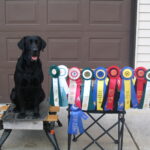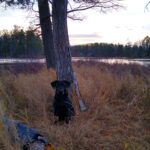About this site




Thank you for visiting
Here’s to the retrievers who make the hunt more than just a pursuit – they make it a profound connection that touches our hearts.
What is a Retriever
A retriever is a type of gun dog that retrieves game for a hunter. Retrievers are bred primarily to retrieve birds or other game and return them to the hunter without damage. Although spaniels and some pointing breeds routinely retrieve game, and many retrievers are skilled in finding game, retrievers are distinguished in that non-slip retrieval is their primary function. As a result, retriever breeds are bred for soft mouths and a great willingness to please, learn, and obey.
Retriever History
The modern Labrador’s ancestors originated on the island of Newfoundland, now part of the province of Newfoundland and Labrador, Canada. The breed emerged over time from the St. John’s Water Dog, (also a founding breed of the Newfoundland dog) through ad-hoc breedings by early settlers in the mid to late 16th century. The forebears of the St. John’s Dog are not known, but were likely a random-bred mix of English, Irish, and Portuguese working breeds. The Newfoundland (known then as the Greater Newfoundland) is likely a result of the St. John’s Dog breeding with mastiffs brought to the island by the generations of Portuguese fishermen who had been fishing offshore since the 17th century. The smaller short-coat St. John’s Dog (also known as the Lesser Newfoundland) was used for retrieval and pulling in nets from the water. These smaller dogs were the forebears of the Labrador Retriever. The white chest, feet, chin, and muzzle – known as tuxedo markings – characteristic of the St. John’s Dog often appear in Lab mixes, and will occasionally manifest in Labs as a small white spot on the chest (known as a medallion) or stray white hairs on the feet or muzzle..

Nell – A St. John’s Dog circa 1856.
The St. John’s area of Newfoundland was settled mainly by the English and Irish. Local fishermen originally used the St. John’s dog to assist in carrying ropes between boats, towing dories, and helping to retrieve fishnets in the water. The Labrador’s loyalty and hard working behavior earned him a place on many a fisherman’s boat.
A number of these dogs were brought back to the Poole area of England in the early 19th century, then the hub of the Newfoundland fishing trade, by the gentry, and became prized as sporting and waterfowl hunting dogs. A few kennels breeding these grew up in England; at the same time a combination of sheep protection policy (Newfoundland) and rabies quarantine (England) led to their gradual demise in their country of origin.

A surviving picture of Buccleuch Avon (b.1885), a foundational dog of many modern Labrador lineages.
The first and second Earls of Malmesbury, who bred for duck shooting on his estate, and the 5th and 6th Dukes of Buccleuch, and youngest son Lord George William Montagu-Douglas-Scott, were instrumental in developing and establishing the modern Labrador breed in 19th century England. The dogs Avon (“Buccleuch Avon”) and Ned given by Malmesbury to assist the Duke of Buccleuch’s breeding program in the 1880s are considered the ancestors of all modern Labradors.
The first St. John’s Dog was said to be brought to England around 1820; however, the breed’s reputation had spread to England long before. There is a story that the Earl of Malmesbury saw a St. John’s Dog on a fishing boat and immediately made arrangements with traders to have some of these dogs exported to England. These ancestors of the first labradors so impressed the Earl with their skill and ability for retrieving anything within the water and on shore that he devoted his entire kennel to developing and stabilizing the breed.
